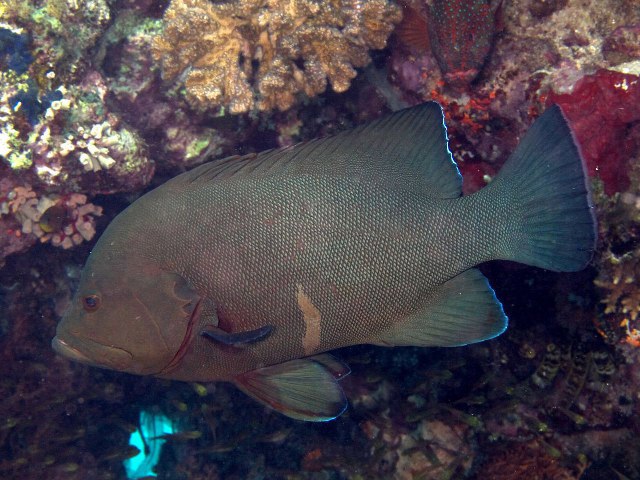| Serranidae (Sea basses: groupers and fairy basslets), subfamily: Epinephelinae |
| 60 cm TL (male/unsexed) |
|
reef-associated; depth range 3 - 60 m, non-migratory |
| Indo-West Pacific: Red Sea to South Africa and east to the Gilbert Islands. Probably found in all tropical islands of the Indian Ocean. Also reported from Persian Gulf (Ref. 68964). Recorded from Europa Island (MNHN 1992-0475, Ref. 33390). |
|
Dorsal spines (total): 9-9; Dorsal soft rays (total): 17-18; Anal spines: 3-3; Anal soft rays: 8-9. Dark brown to black in color, occasionally with an orange cast (Ref 5222); color in market is dark brown without distinguishing marks (Ref. 89707); Inside of this grouper's mouth ranges from light pink to crimson. Juveniles have a white border on the caudal fin (Ref. 37816); further characterized by having relatively deep body; greatest depth 2.1-2.4 in SL; width 2.3-2.8 times in depth (Ref. 89707); truncate caudal fin; longest pectoral rays fifth or sixth (Ref. 90102); head length 2.5-2.7 times in SL; convex interorbital area; dorsal head profile steep, straight or slightly concave along the snout and distinctly convex from eye to dorsal fin; preorbital depth 6.5-9.2 times in HL; finely serrate preopercle, fleshy lower edge; smooth subopercle and interopercle or with minute serrae; opercle with three flat spines, middle one closer to the lower spine; upper edge of operculum convex; posterior nostril round or oval; maxilla reaches past eye; ventro-posterior corner of maxilla with distinct bony protuberance; slender supramaxilla; small canine at front of jaws, none elsewhere; 2-4 rows of small slender teeth at side of lower jaw; presence of palatine teeth; well-developed scaly flap of skin joining upper pectoral-fin rays to body; pectoral fins asymmetrical; pelvic fins subequal to pectoral fins, reaching to or beyond anus; caudal fin with 8 branched rays and 9 procurrent rays in upper part and 7 branched rays and 8 procurrent rays in lower part; body scales ctenoid, with auxiliary scales (Ref. 89707). |
| Found in coastal reefs and lagoons, often silty habitat (Ref. 48635), in or near caves and holes in the reef. Feeds mainly on small fishes (including Pempheris sp.), also on stomatopods (Pseudosquilla sp.) (Ref. 6448); and crustaceans (Ref. 37816). Preliminary data indicate that it spawns at any time of the year and matures (females?) at about 35 cm SL (Ref. 6448). Small juveniles mimic Centropyge vrolikii (Ref. 8631), and C. nox until they outgrow their model in size (Ref. 48635). Taken as part of the live reef food fish trade centered in China and In Hong Kong; occasionally found in markets (Ref. 89707). |
|
Data deficient
(Ref. 96402)
|
| harmless |
|
Source and more info: www.fishbase.org. For personal, classroom, and other internal use only. Not for publication.
Page created by Jen, 05.08.02,
php script by kbanasihan 06/09/2010 ,
last modified by
dsantos, 20/08/10

